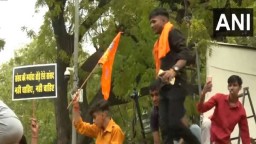Latest News
YOUNG NaMo SPREADING DEMOCRATIC IDEOLOGIES

How Modi’s presence of mind was his trump card during Emergency
On June 25, 1975, the authoritarian Indira Gandhi government imposed the Emergency on the world’s largest democracy. Fundamental rights were curtailed, and democracy was strangled. It remains the darkest chapter in the seven decades of independent India’s history. During this period, Narendra Modi, a young RSS Pracharak in his early 20s, known for his exceptional organisational skills, played a crucial role in the fight to save democracy. With most of his seniors jailed, the responsibility of coordinating the anti-Emergency movement fell upon young Modi’s shoulders, all while avoiding arrest.
He was appointed the Gujarat state General Secretary of the Lok Sangharsh Samiti, led by Jayprakash Narayan at the national level. He was entrusted with key responsibilities including publishing, printing, and distributing anti-Emergency literature, organising Satyagraha, managing logistics for national leaders travelling through Gujarat, ensuring the well-being of families of jailed workers, and, most importantly, maintaining the momentum of the resistance.
Nationwide awareness against the Emergency largely relied on anti-Emergency literature, given the impossibility of public meetings and the censorship of the press. In this context, Narendra Modi took charge of coordinating the printing of anti-Emergency literature in Gujarat. He translated pamphlets published in English and Hindi into Gujarati, arranged for their printing.
Narendra Modi was well aware that Ahmedabad was wellconnected through the railway network to places outside Gujarat like Bihar, Kolkata, Madras, Uttar Pradesh, etc. So he utilised the railways to send booklets and pamphlets printed in Gujarat to other states. He even ensured that this literature reached the hands of foreign leaders and journalists visiting India. He abstained from sending the material by post for fear of being censured and caught and devised the idea to use the railway mail for the purpose.
In another important tactical move, he suggested placing the literature in barber shops so that people coming there could read it. He recommended giving literature to local religious leaders and saints, who could distribute them among devotees attending their spiritual discourses. This way the spread and propagation of anti-Emergency narrative could be expedited and widely circulated to generate a strong public opinion against the Indira government and its anti-democratic moves.
Narendra Modi’s sagacity was also visible at another instance. To ensure that no karyakarta was caught, he made this rule that whenever their phone numbers were written or exchanged, the last two digits were to be interchanged so that if caught, the police would never be able to reach them through their contact numbers. This was a masterstroke of secrecy.
He was also concerned about the safety and welfare of the families of the jailed leaders and karyakartas. He personally visited the families in need and through hideous donations or other innovative ways of pooling resources, delivered them food, medicines, clothes or financial help according to their requirements. He considered every such family his very own and treated them that way.
For his sagacity and tactical moves, Narendra Modi was never caught by the police, which helped him continue his work undisturbed. He travelled across the state and even outside in various disguises, often posing as a Sardarji or a Sadhu. Old associates of Modi recall that it was difficult even for them to recognise him, let alone the police. During the Emergency, Narendra Modi used to visit us posing as an incense stick salesman and sometimes even dressed as a Pathan.
One day in September 1976, Modi ji entered the Bhavnagar jail dressed as a Sadhu and spent almost an hour with some senior karyakartas lodged there, discussing the struggle against the Emergency. No one suspected that the person was Narendra Modi! Modi adeptly dodged the police many times. During the anti-Emergency activities, Narendra Modi visited Ahmedabad. One day, just as Modi, dressed as a Sikh youth, was about to leave the house where he was putting up, a police team arrived based on a tip off they had received. Narendra Modi was stepping out when the police team intercepted him and asked, ‘Do you know if someone named Narendra Modi is residing here?’ Modi ji remained calm and replied that he was unaware, suggesting that the police search other houses in the area. The police continued their futile search, and Narendra Modi, confidently maintaining his disguise, calmly walked away from the situation, narrowly escaping arrest.
Once Narendra Modi was traveling in a rickshaw with anti-Emergency literature. A police team stopped the rickshaw, but a vigilant Modi immediately informed the officers that he worked at the local university and was en route to deliver exam papers. Modi suggested the police open the bundle to verify, but since the papers were confidential, he advised them to accompany him to the university and clarify the situation to the officials. The police refrained from touching the bundle, allowing Modi to make a smooth escape. To avoid arrest, Narendra Modi assumed different identities and adopted various aliases.
COMPILED AND EDITED BY SHASHIKANT SHARMA












.jpg)
.jpg)
.jpg)
.jpg)
.jpg)



